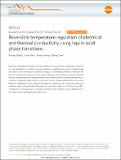| dc.contributor.author | Zheng, Ruiting | |
| dc.contributor.author | Gao, Jinwei | |
| dc.contributor.author | Wang, Jianjian | |
| dc.contributor.author | Chen, Gang | |
| dc.date.accessioned | 2013-11-25T19:35:33Z | |
| dc.date.available | 2013-11-25T19:35:33Z | |
| dc.date.issued | 2011-04 | |
| dc.date.submitted | 2012-12 | |
| dc.identifier.issn | 2041-1723 | |
| dc.identifier.uri | http://hdl.handle.net/1721.1/82586 | |
| dc.description.abstract | Reversible temperature tuning of electrical and thermal conductivities of materials is of interest for many applications, including seasonal regulation of building temperature, thermal storage and sensors. Here we introduce a general strategy to achieve large contrasts in electrical and thermal conductivities using first-order phase transitions in percolated composite materials. Internal stress generated during a phase transition modulates the electrical and thermal contact resistances, leading to large contrasts in the electrical and thermal conductivities at the phase transition temperature. With graphite/hexadecane suspensions, the electrical conductivity changes 2 orders of magnitude and the thermal conductivity varies up to 3.2 times near 18 °C. The generality of the approach is also demonstrated in other materials such as graphite/water and carbon nanotube/hexadecane suspensions. | en_US |
| dc.description.sponsorship | National Science Foundation (U.S.) (Grant CBET-0755825) | en_US |
| dc.description.sponsorship | National Science Foundation (U.S.) (Grant CTS-0506830) | en_US |
| dc.language.iso | en_US | |
| dc.publisher | Nature Publishing Group | en_US |
| dc.relation.isversionof | http://dx.doi.org/10.1038/ncomms1288 | en_US |
| dc.rights.uri | http://creativecommons.org/licenses/by-nc-sa/3.0/ | en_US |
| dc.source | PMC | en_US |
| dc.title | Reversible temperature regulation of electrical and thermal conductivity using liquid–solid phase transitions | en_US |
| dc.type | Article | en_US |
| dc.identifier.citation | Zheng, Ruiting, Jinwei Gao, Jianjian Wang, and Gang Chen. “Reversible temperature regulation of electrical and thermal conductivity using liquid–solid phase transitions.” Nature Communications 2 (April 19, 2011): 289. © 2011 Nature Publishing Group, a division of Macmillan Publishers Limited | en_US |
| dc.contributor.department | Massachusetts Institute of Technology. Department of Mechanical Engineering | en_US |
| dc.contributor.mitauthor | Wang, Jianjian | en_US |
| dc.contributor.mitauthor | Chen, Gang | en_US |
| dc.contributor.mitauthor | Zheng, Ruiting | en_US |
| dc.contributor.mitauthor | Gao, Jinwei | en_US |
| dc.relation.journal | Nature Communications | en_US |
| dc.eprint.version | Final published version | en_US |
| dc.type.uri | http://purl.org/eprint/type/JournalArticle | en_US |
| eprint.status | http://purl.org/eprint/status/PeerReviewed | en_US |
| dspace.orderedauthors | Zheng, Ruiting; Gao, Jinwei; Wang, Jianjian; Chen, Gang | en_US |
| dc.identifier.orcid | https://orcid.org/0000-0001-9954-6895 | |
| dc.identifier.orcid | https://orcid.org/0000-0002-3968-8530 | |
| mit.license | PUBLISHER_CC | en_US |
| mit.metadata.status | Complete | |
